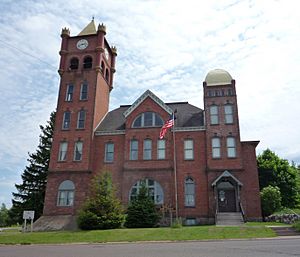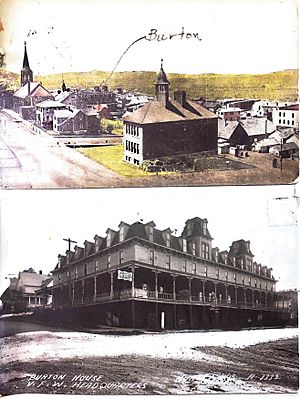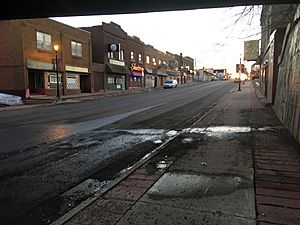Hurley, Wisconsin facts for kids
Quick facts for kids
Hurley, Wisconsin
|
|
|---|---|
|
City
|
|
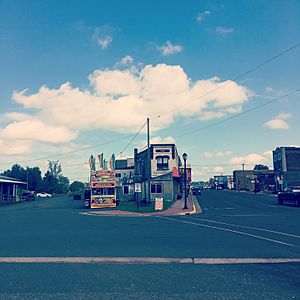 |
|
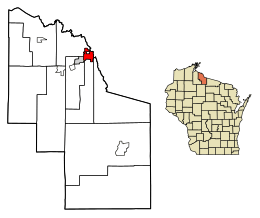
Location of Hurley in Iron County, Wisconsin.
|
|
| Country | United States |
| State | Wisconsin |
| County | Iron |
| Area | |
| • Total | 3.38 sq mi (8.76 km2) |
| • Land | 3.23 sq mi (8.37 km2) |
| • Water | 0.15 sq mi (0.39 km2) |
| Elevation | 1,496 ft (456 m) |
| Population
(2020)
|
|
| • Total | 1,558 |
| • Density | 444.31/sq mi (171.56/km2) |
| Time zone | UTC-6 (Central (CST)) |
| • Summer (DST) | UTC-5 (CDT) |
| Zip Code |
54534
|
| Area code(s) | 715 & 534 |
| FIPS code | 55-36525 |
| GNIS feature ID | 1566822 |
| Website | https://cityofhurleywi.org |
Hurley is a city in Iron County, Wisconsin, United States. It is the main city, or county seat, of Iron County. In 2020, about 1,558 people lived there. Hurley is right across the Montreal River from Ironwood, Michigan.
Contents
Exploring Hurley's Past
Hurley is located on the Montreal River. This river forms the border between Wisconsin and the Upper Peninsula of Michigan. The city was started to help both lumbermen (people who cut down trees) and miners. Hurley and a nearby town called Gile were known for lumber. Other towns like Montreal and Ironwood, Michigan were mining towns.
How Hurley Got Its Name
Hurley was named after M. A. Hurley. He was a well-known lawyer from Wausau. In 1884, he won a big lawsuit for a company called Northern Chief Iron Company. Instead of money, he asked for the town involved in the case to be named after him. For one year, the town was called "Glen Hurley." But in 1885, the "Glen" was dropped, and it became just Hurley.
Henry Meade was the first mayor of Hurley. John Ankers opened the first saloon. He also served as the first town clerk, justice of the peace, and fire chief.
Fires and Rebuilding
In 1888, the Gogebic Range Directory reported that Hurley had two big fires. The first was on June 28, and the second was on July 9. These fires destroyed almost all the businesses in the city. At first, people thought the fires would ruin the town. But the business owners were very determined. They quickly started building new, strong brick buildings. Because of this, the burned areas were rebuilt with brick and stone. This made them much safer from fire. Silver Street became a street that even much larger cities would be proud of.
Historic Places in Hurley
The Iron Exchange Bank of Hurley was the oldest bank in the Gogebic Range area. It started on November 26, 1885. Dr. J.C. Reynolds and his brother, W. S. Reynolds, were key in starting the bank. Many important mining leaders were also involved. By 1925, the bank had survived all financial challenges.
The first place to buy meat in Hurley was Ilsey and Knox's meat market. It opened in 1885.
Hurley's first newspaper was the Montreal River Miner. It was first printed on October 8, 1885. In 1950, it joined with the Iron County News. The new paper was called the Iron County Miner, and it is still printed every week.
The first hotel in Hurley was a log building. It was on the corner of Second Avenue and Silver Street. James Guest was the first owner. It was a simple place but provided food and shelter for many early settlers and miners.
The Famous Burton House
The Burton House was a huge four-story hotel. It was a very popular meeting spot in the late 1800s. John E. Burton built the hotel in 1886. He was a mining investor who made his money from the iron mines. Later, he bought more mining interests in other countries.
The Burton Hotel had 100 rooms, a ballroom, a dining room, a café, and clubrooms. Everything was beautifully decorated with fine wood and furniture. The hotel cost $35,000 to build, and the furniture cost $10,000. Many famous people stayed at the Burton House. These included:
- Benjamin Harrison, who visited in 1888 while running for president.
- The actress Sarah Bernhardt.
- The financier Colgate Hoyt.
- The actor Edwin Booth.
- The author and playwright Edna Ferber.
- Grover Cleveland, who stayed there on October 5, 1889. He had already been president once and would be elected again in 1892.
Sadly, the Burton House burned down on February 2, 1947. An overheated stove in a meeting room caused the fire.
Mining in Hurley
Hurley and the towns around it were started because iron ore was discovered there. Iron ore is a rock from which iron can be extracted.
In 1965, the last mine in Hurley, called the Cary Mine, closed. After the mines closed, many people left the area. They often moved to factories in cities like Racine and Kenosha, Wisconsin. This caused the economy of Hurley to decline. Some former miners found jobs at the White Pine Copper Mine in Michigan. They would drive 60 miles each way to work.
Hurley's Location and Climate
Hurley is located at 46°27′1″N 90°11′23″W / 46.45028°N 90.18972°W.
The city covers about 3.58 square miles (8.76 square kilometers). Most of this is land, and a small part is water. It is across the state border and the Montreal River from Ironwood, Michigan.
Hurley's Weather
Hurley has a cool humid continental climate. This means it has long, cold winters and short, mild summers.
- On average, the temperature drops below 32 °F (0 °C) for 192 days each year.
- It gets colder than 0 °F (-17.8 °C) for about 40 days each year.
- Hurley is one of the snowiest cities in the United States. It gets over 160 inches of snow every year!
People of Hurley
| Historical population | |||
|---|---|---|---|
| Census | Pop. | %± | |
| 1900 | 2,440 | — | |
| 1910 | 2,934 | 20.2% | |
| 1920 | 3,188 | 8.7% | |
| 1930 | 3,264 | 2.4% | |
| 1940 | 3,375 | 3.4% | |
| 1950 | 3,034 | −10.1% | |
| 1960 | 2,763 | −8.9% | |
| 1970 | 2,418 | −12.5% | |
| 1980 | 2,015 | −16.7% | |
| 1990 | 1,782 | −11.6% | |
| 2000 | 1,818 | 2.0% | |
| 2010 | 1,547 | −14.9% | |
| 2020 | 1,558 | 0.7% | |
| U.S. Decennial Census | |||
In 2010, there were 1,547 people living in Hurley. Most residents (97.5%) were White. About 16.2% of the people were under 18 years old. The average age in the city was 49 years.
Learning and Faith
Gogebic Community College is a two-year college nearby in Ironwood, Michigan. It started in 1932 and has about 1,000 students.
The Hurley K-12 School is just outside Hurley. It was built in 1991. This school serves students from kindergarten through 12th grade from northern Iron County. About 550 students attend the school.
At different times, Hurley has had six Christian churches and one Jewish place of worship.
Getting Around Hurley
Roads
 US 2 goes west towards Ashland, Wisconsin and Duluth, Minnesota. It also goes east to Iron Mountain, Michigan.
US 2 goes west towards Ashland, Wisconsin and Duluth, Minnesota. It also goes east to Iron Mountain, Michigan. US 51 ends in Hurley. If you go south on US 51, you will reach Wausau, Wisconsin.
US 51 ends in Hurley. If you go south on US 51, you will reach Wausau, Wisconsin. WIS 77 starts near the state line in Hurley and travels southwest.
WIS 77 starts near the state line in Hurley and travels southwest.
Public Transport and Airport
Bus service is available from Indian Trails.
The Gogebic-Iron County Airport (KIWD) offers commercial flights.
Railroads
In the past, Hurley was served by two main train lines. The Chicago & North Western Flambeau Line ran between Chicago and Ashland. The Soo Line Railroad ran between Minneapolis and Bessemer.
Another line, the Duluth, South Shore and Atlantic Railway, passed a few miles north of Hurley. This line went from Superior to Sault Ste Marie.
Media and Fun
WHRY-AM and WUPM-FM are the two local radio stations in Hurley. You can also listen to stations from Ironwood, Michigan.
Things to Do and See
- The Iron Belle Trail starts in Hurley. This is a path for walking or biking. It follows old train tracks from Hurley to Ramsay, Michigan.
- Hurley is close to many beautiful waterfalls.
- The SISU Cross Country Ski Race happens every January in nearby Ironwood, Michigan.
- The Paavo Nurmi Marathon is held in Hurley every August. It is one of the oldest marathons in the United States.
Hurley celebrates its Italian background at the annual Festivale de Italiano. This event takes place every Labor Day weekend.
The National Finnish American Festival Cultural Center (NFAF) is located near Hurley. They have events like Viola Turpeninen Day, which celebrates a famous Finnish-American musician. The NFAF museum is open from April to December.
Hurley is also known for its exciting ATV (All-terrain vehicle) rallies.
- The Hurley ATV Rally is held on Memorial Day weekend.
- A Pumpkin ATV rally is held in October.
- The Red Light Snowmobile Rally is another popular event.
These rallies bring thousands of visitors to the area. In 2005, the Hurley ATV rally set a Guinness World Record for the largest ATV parade, with 687 ATVs!
Riccelli Park is in Hurley. It has picnic areas, playgrounds, and a pavilion for gatherings. The Felix Patritto baseball field is next to Riccelli Park.
Notable People from Hurley
- Paul Alfonsi, a Wisconsin State Representative.
- Karen Borca, a jazz bassoon player.
- Len Calligaro, a football player.
- Everis A. Hayes, a U.S. Representative from California.
- Alvin O'Konski, a U.S. Representative.
- Frank Rooney, a baseball player.
- Robert (Bob) Sohl, an Olympic bronze medal-winning swimmer.
- Joseph Sullivan, an FBI inspector who led a major investigation.
Images for kids
See also
 In Spanish: Hurley (Wisconsin) para niños
In Spanish: Hurley (Wisconsin) para niños


